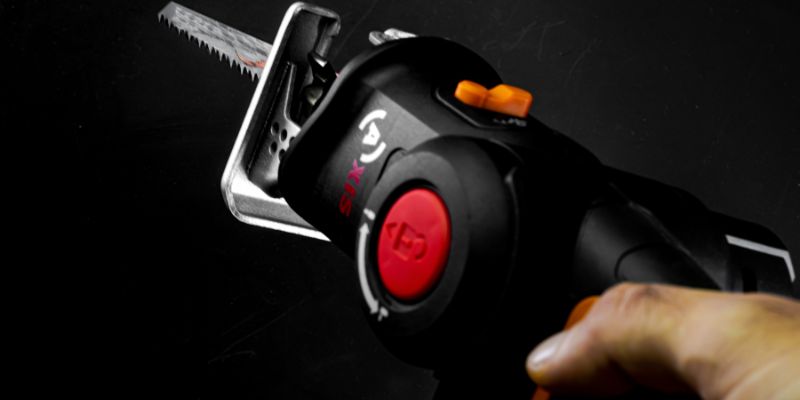Oscillating tools and reciprocating saws are both versatile power tools, but they have distinct differences. Oscillating tools are ideal for precision cutting, sanding, and scraping tasks while reciprocating saws are designed for heavy-duty demolition and rough-cutting jobs.
Oscillating tools and reciprocating saws are two powerful tools that can be found in the arsenal of any DIY enthusiast or professional contractor. Each of these tools has unique features and capabilities that make them suitable for specific tasks, allowing you to tackle various projects with ease and efficiency.
Whether you are a hobbyist working on a home renovation project or a contractor completing a construction job, understanding the differences between an oscillating tool and a reciprocating saw is crucial to choosing the right tool for the job. We will take a closer look at these two tools, comparing their functionalities and helping you determine which one is best suited to your specific needs. So, without further ado, let’s delve into the world of oscillating tools and reciprocating saws and explore their similarities, differences, and uses.
Features And Functions
When it comes to power tools, it can be overwhelming to choose the right one for your needs. Two popular options that often come up in this search are the oscillating tool and the reciprocating saw. While they both have their own strengths and applications, understanding their features and functions is key to making an informed decision.
Oscillating Tool Features
The oscillating tool is known for its versatility and precision. With a rapid back-and-forth motion, it allows for detailed work in tight spaces. Here are some key features of an oscillating tool:
- Versatility: An oscillating tool can be used for a wide range of tasks, from cutting and sanding to scraping and grinding. Its compatibility with various attachments makes it a great all-rounder.
- Precision: The oscillating motion of the tool enables precise control over cuts and other operations. This makes it ideal for tasks that require accuracy and finesse.
- Access: Thanks to its slim profile and narrow blade, an oscillating tool can reach tight corners and awkward angles that other power tools struggle with.
- Low Vibration: Compared to some other power tools, the oscillating tool tends to produce less vibration, resulting in reduced fatigue during longer periods of use.
Reciprocating Saw Features
The reciprocating saw, on the other hand, is a great option for heavy-duty cutting, demolition, and pruning. Its back-and-forth motion allows for quick and powerful cuts. Let’s take a look at its features:
- Power: A reciprocating saw is known for its sheer power, making it suitable for tasks that require cutting through thick materials, such as wood, metal, and even masonry.
- Speed: Due to its aggressive cutting action, a reciprocating saw is capable of making fast cuts. This makes it ideal for tasks that require efficiency and speed.
- Stability: Reciprocating saws are typically built with a sturdy frame and handle, providing stability and control while making those heavy-duty cuts.
- Blade Options: Reciprocating saws offer a wide range of blade options, including specialized blades for specific materials and tasks. This allows for greater versatility in different cutting applications.

Key Differences Between Oscillating Tool And Reciprocating Saw
While both the oscillating tool and reciprocating saw have their own unique features and functions, there are some key differences worth considering:
| Oscillating Tool | Reciprocating Saw |
|---|---|
| Better suited for precision work in tight spaces | Ideal for heavy-duty cutting and demolition |
| Offers versatility with a wide range of attachments | Provides speed and power for efficient cutting |
| Produces less vibration, reducing user fatigue | May produce more vibration due to its powerful cutting action |
| Accesses hard-to-reach areas with its slim profile | Requires more space for maneuvering due to its longer blade |
Applications And Uses
Understanding the applications and uses of different tools is essential to ensure their effective utilization for various tasks. In this section, we will delve into the applications and uses of two versatile power tools: the oscillating tool and the reciprocating saw. Each tool excels in different tasks, making them indispensable in the toolbox of any DIY enthusiast or professional contractor.
Oscillating Tool Applications
The oscillating tool, with its precise and controlled cutting action, offers a wide range of applications. Its versatility allows it to excel in various tasks, making it an invaluable tool in many situations. Here are some common applications where the oscillating tool shines:
- Flush cutting – With its ability to make flush cuts in tight spaces, the oscillating tool is ideal for trimming door jambs, baseboards, and other materials without damaging the surrounding surfaces.
- Sanding and scraping – Equipped with sanding and scraping attachments, the oscillating tool can effortlessly remove paint, adhesive, and rust, as well as smooth out rough surfaces.
- Cutting and shaping – Whether it’s cutting through wood, metal, or plastic, the oscillating tool’s oscillating motion provides precise control and allows it to tackle intricate cuts.
- Grout removal – The oscillating tool’s slim profile and specialized grout removal blade make it an excellent choice for removing grout between tiles, saving time and effort.
Reciprocating Saw Applications
The reciprocating saw, also known as a sawzall, is a powerful cutting tool with a wide range of applications. Its aggressive cutting action, coupled with its ability to maneuver in tight spaces, makes it an indispensable tool for many tasks. Here are some common applications where the reciprocating saw excels:
- Demolition and remodeling – Whether demolishing walls or cutting through nails, the reciprocating saw’s powerful motor and long blade stroke make quick work of tough materials.
- Pruning and tree cutting – With the appropriate blade, the reciprocating saw can effortlessly tackle pruning tasks, making it a handy tool for gardeners and arborists.
- Pipe and metal cutting – The reciprocating saw’s ability to cut through various materials, including metal pipes and sheet metal, makes it a go-to tool for plumbers and metalworkers.
- Window and door framing – When it comes to rough carpentry tasks, such as cutting openings for windows and doors, the reciprocating saw’s speed and power make it the tool of choice.
Comparison Of Applications And Best Usage Scenarios
While both the oscillating tool and reciprocating saw have their unique applications, understanding their best usage scenarios can help you make the right choice for your specific needs. Here’s a quick comparison:
| Tool | Best Usage Scenarios |
|---|---|
| Oscillating Tool | Trimming, sanding, scraping, precise cutting, grout removal |
| Reciprocating Saw | Demolition, remodeling, pruning, pipe cutting, rough carpentry tasks |
Ultimately, the choice between the oscillating tool and the reciprocating saw depends on the task at hand. Consider the nature of your project and the specific materials you need to work with to determine which tool will best meet your needs. Having both tools in your toolbox will ensure you are well-equipped for a wide range of applications.

Frequently Asked Questions For Oscillating Tool Vs Reciprocating Saw
Is A Circular Saw The Same As An Oscillating Tool?
No, a circular saw is not the same as an oscillating tool. They are two separate tools with different functions. While a circular saw is used for cutting through materials in a straight line, an oscillating tool is versatile and can perform various tasks like sanding, scraping, and cutting in tight spaces.
Are Oscillating Tools Good For Cutting Metal?
Yes, oscillating tools are good for cutting metal due to their versatility and precision. The high-speed oscillation allows for clean and accurate cuts, making them ideal for various metal-cutting tasks.
Can An Oscillating Multi-tool Cut Wood?
Yes, an oscillating multi-tool can cut wood efficiently due to its versatile blade. It is designed to make precise cuts in various materials, including wood.
What Is The Difference Between Reciprocating And Oscillating Saw Surgery?
Reciprocating saw surgery uses a back-and-forth motion while cutting while oscillating saw surgery moves side-to-side.
Conclusion
To sum up, both the oscillating tool and reciprocating saw have their own unique features and advantages. The oscillating tool offers versatility and precision, making it ideal for delicate tasks. On the other hand, the reciprocating saw provides power and strength, making it a go-to for heavy-duty projects.
Ultimately, the choice between the two depends on your specific needs and preferences. So, weigh the pros and cons, consider your requirements, and make an informed decision for your next project. Happy DIYing!


